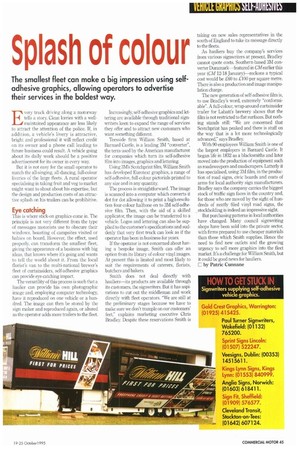Splash of colour
Page 47

If you've noticed an error in this article please click here to report it so we can fix it.
The smallest fleet can make a big impression using selfadhesive graphics, allowing operators to advertise their services in the boldest way.
F4 very truck driving along a motorway tells a story. Clean lorries with a well
maintained appearance are less likely to attract the attention of the police. If, in addition, a vehicle's livery is attractive, bright and professional it will reflect credit on its owner and a phone call leading to future business could result. A vehicle going about its daily work should be a positive advertisement for its owner in every way But it is not easy for the small operator to match the all-singing, all-dancing, full-colour liveries of the large fleets. A rural operator specialising in taking fruit and veg to market might want to shout about his expertise, but the design and production costs of an attractive splash on his trailers can be prohibitive.
Eye catching
This is where stick-on graphics come in. The principle is not very different from the type of messages motorists use to obscure their windows, boasting of campsites visited or babies on board. However, the effect, used properly, can transform the smallest fleet, giving the appearance of a business with big ideas, that knows where it going and wants to tell the world about it. From the local florist's van to the multi-national brewer's fleet of c-urtainsiders, self-adhesive graphics can provide eye-catching impact.
The versatility of this process is such that a haulier can provide his own photographic image and, employing computer technology, have it reproduced on one vehicle or a hundred. The image can then be stored by the sign maker and reproduced again, or altered as the operator adds more trailers to the fleet. Increasingly, self-adhesive graphics and lettering are available through traditional signwriters keen to expand the range of services they offer and to attract new customers who want something different.
Teesside firm William Smith, based at Barnard Castle, is a leading 3M "converter", the term used by the American manufacturer for companies which turn its self-adhesive film into images, graphics and lettering.
Using 3M's Scotchprint film, William Smith has developed Eurotext graphics, a range of self-adhesive, full-colour pictorials printed to any size and in any quantity.
The process is straightforward. The image is scanned into a computer which converts it dot for dot allowing it to print a high-resolution four-colour halftone on to 3M self-adhesive film. Then, with the aid of a skilled applicator, the image can be transferred to a vehicle. Logos and lettering can also be supplied to the customer's specifications and suddenly that very first truck can look as if the operator has been in business for years.
If the operator is not concerned about having a bespoke image, Smith can offer an option from its library of colour vinyl images. At present this is limited and most likely to suit the requirements of caterers, florists, butchers and bakers.
Smith does not deal directly with hauliers—its products are available through its customers, the signwriters. But it has aspirations to cut out the middleman and work directly with fleet operators. "We are still at the preliminary stages because we have to make sure we don't trample on our customers' feet," explains marketing executive Chris Bradley. Despite these reservations Smith is taking on new sales representatives in the south of England to take its message directly to the fleets.
As hauliers buy the company's services from various sigmwriters at present, Bradley cannot quote costs. Southern-based 3M converter au-amark—featured in CMearlier this year (CM 12-18 January)—reckons a typical cost would be £60 to £100 per square metre. There is also a production and image manipulation charge.
The new generation of self-adhesive film is, to use Bradley's word, extremely "conformiable". A full-colour, wrap-around curtainsider trailer for Labatt's brewery shows that the film is not restricted to flat surfaces. But nothing stands still: "We are concerned that Scotchprint has peaked and there is stuff on the way that is a lot more technologically advanced," says Bradley.
With 90 employees William Smith is one of the largest employers in Barnard Castle. It began life in 1832 as a blacksmiths and later moved into the production of equipment such as roadsweepers and mudscrapers. Latterly it has specialised, using 3M film, in the production of road signs, civic boards and coats of arms for local authority sign manufacturers. Bradley says the company carries the biggest stock of traffic sign faces in the country and, for those who are moved by the sight of hundreds of neatly filed vinyl road signs, the _ stockholding is indeed an impressive sight.
But purchasing patterns in local authorities have changed. Many council signwriting shops have been sold into the private sector, with firms prepared to use cheaper materials than those which Smith supplies. Hence the need to find new outlets and the growing urgency to sell more graphics into the fleet market. It's a challenge for William Smith, but it could be good news for hauliers.
E by Patric Cunnane












































































































































